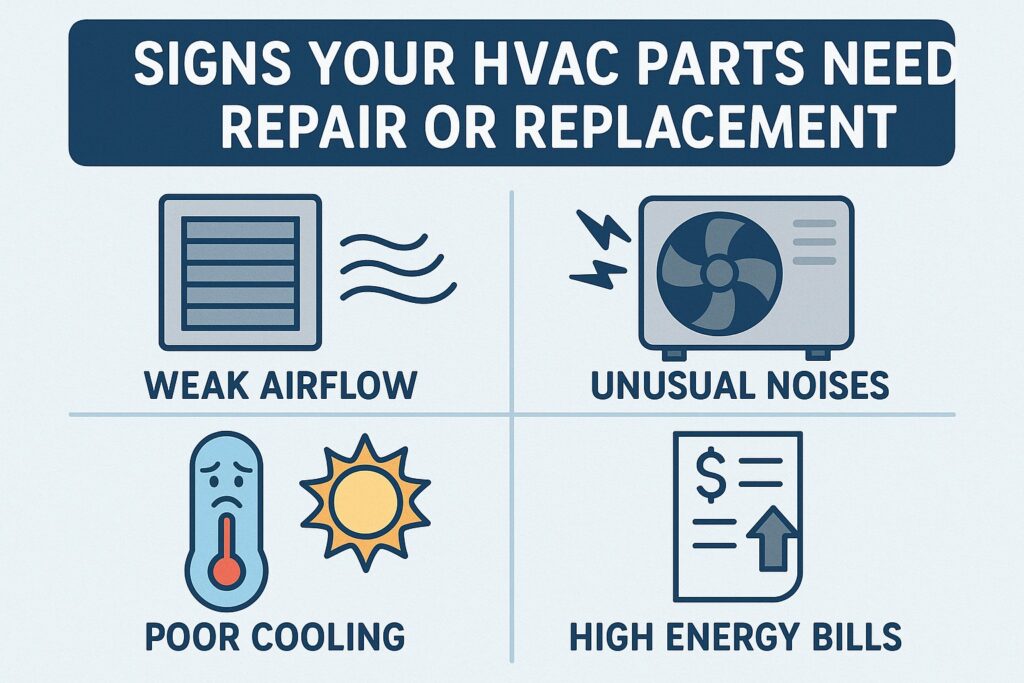
Keeping your HVAC system running smoothly means paying attention to the small signals it gives you. HVAC systems are made up of many moving parts — compressors, condensers, evaporator coils, blower motors, capacitors, thermostats, and more — and when one piece starts failing, the whole system’s comfort, efficiency, and safety can be affected.
This article breaks down the most common, real-world signs that your HVAC parts need repair or replacement. I’ll use plain language, include practical troubleshooting steps you can try safely, and explain when it’s time to call a licensed technician. Think of this as your go-to checklist for HVAC trouble-before-it-becomes-a-crisis.
Why parts fail: a quick primer
HVAC parts wear out for predictable reasons:
- Age & normal wear: Mechanical and electrical components lose efficiency over many years.
- Lack of maintenance: Dirty filters, clogged coils, and missed tune-ups accelerate failure.
- Electrical issues: Faulty capacitors, relays, and wiring cause intermittent or total failures.
- Refrigerant problems: Leaks or undercharge reduce cooling and stress compressors.
- Environmental stress: Corrosion from salt air, debris-clogging, or ice formation.
Understanding these causes helps you catch problems earlier and decide whether a repair or replacement is the right move.
12 signs your HVAC parts need repair or replacement
1. Strange or loud noises
What you might hear: banging, clanking, grinding, squealing, rattling, or loud humming.
Why it matters:
- Squealing often points to a worn blower belt or motor bearings.
- Grinding or rubbing can indicate failing bearings in the blower motor or fan.
- Banging may be a loose part, a cracked heat exchanger, or debris in the outdoor unit.
- Rattling commonly means panels, fan blades, or mounting brackets are loose.
What to do: Turn the system off and inspect visible panels for loose screws (only if safe). If the noise is electrical or sounds like metal against metal, shut the system off and call a pro. Continued operation can cause more damage.
2. Higher-than-normal energy bills
What you might see: a sudden spike in electricity or gas usage without a change in behavior or weather.
Why it matters:
Failing parts (dirty coils, a weak compressor, struggling motors, failing capacitors) force your HVAC to run longer and work harder, draining more energy.
What to do: Check and replace filters, clean vents, and make sure registers aren’t blocked. If bills remain high, schedule a professional energy audit and system inspection.
3. Short cycling (system turns on and off frequently)
What you might notice: the HVAC starts, runs briefly, then shuts off — repeatedly.
Why it matters:
Short cycling reduces comfort, increases wear, and often signals: improper sizing, a bad thermostat, low refrigerant, a failing compressor, or an overheating blower motor.
What to do: Replace/clean the thermostat batteries and check settings. If short cycling continues, call an HVAC technician for diagnostics.
4. Weak or uneven airflow
What you might experience: rooms that never reach the set temperature, weak air from vents, or some rooms too hot/cold.
Why it matters:
Issues with the blower motor, clogged air filters, blocked ductwork, or a failing fan can reduce airflow. If the evaporator coil is frozen, airflow may also drop.
What to do: Replace filters, check vents, and clean duct registers. If problems persist, get a technician to inspect the blower motor and ductwork.
5. The AC is running but blowing warm air (or heat pump won’t heat)
What you’ll notice: compressor runs, outdoor unit hums, but indoor air is warm.
Why it matters:
This often indicates low refrigerant (a leak), a failing compressor, or a clogged condenser coil. For heat pumps, reversing valve or compressor issues may be the cause.
What to do: Turn off the system to avoid further damage and call a certified HVAC technician — refrigerant work must be handled by licensed professionals.
6. Water leaks or pooling around the unit
What you might see: water near the indoor furnace/air handler, or around the outdoor condenser.
Why it matters:
Clogged condensate drains, cracked drain pans, or frozen evaporator coils can cause leaks. In severe cases, water can damage ceilings, walls, and electrical components.
What to do: Check the condensate drain for obvious clogs (if accessible and safe). If water is coming from the outdoor unit or you can’t access the drain, call a technician.
7. Ice buildup on the evaporator coil or refrigerant lines
What you might notice: white/blue ice on copper lines or coils, reduced cooling capacity.
Why it matters:
Ice forms when refrigerant levels are low or airflow is insufficient — both stress the compressor and can cause long-term damage.
What to do: Turn off cooling and let the ice melt. Replace the filter and ensure airflow is clear. Contact a technician to check refrigerant and inspect the system.
8. Frequent tripped breakers or blown fuses
What you might experience: HVAC trips the circuit breaker or requires fuse replacement.
Why it matters:
Electrical components like the compressor motor, fan motor, or a failing capacitor can draw excessive current. Repeated trips can damage electrical panels or the unit.
What to do: Don’t repeatedly reset breakers — call a licensed electrician or HVAC tech to diagnose. It could be a serious electrical fault.
9. Strange smells when the system runs
What you might smell: burnt plastic, musty/mildew, rotten eggs (sulfur), or chemical odors.
Why it matters:
- Burnt smells can indicate electrical problems (motors, wiring) — stop using the system and call a pro.
- Musty odors often mean mold or a dirty condensate drain/evaporator coil.
- Sulfur (rotten eggs) could be a gas leak — leave the area and call emergency services and your utility provider immediately.
What to do: Address odors promptly — some signal immediate safety hazards.
10. Thermostat problems and inaccurate temperatures
What you might notice: system not following thermostat settings, delayed responses, or wildly inaccurate readings.
Why it matters:
A malfunctioning thermostat or faulty temperature sensor can cause poor comfort and unnecessary system cycling.
What to do: Replace thermostat batteries, confirm settings, and consider upgrading to a programmable or smart thermostat. If problems persist, have a technician test the thermostat wiring and sensors.
11. Visible rust, corrosion, or oil stains on components
What you might see: corroded fins on condenser coils, rusted panels, or oil on the compressor.
Why it matters:
Corrosion can reduce heat transfer and indicate age. Oil stains around the compressor are a serious sign of refrigerant leaks or internal mechanical failure.
What to do: Corroded outdoor units in coastal or salty areas may need more frequent replacement. Oil leaks require immediate professional attention.
12. System age and frequent breakdowns
What to note: an older HVAC system needing repairs more often.
Why it matters:
Parts wear out; beyond a certain age (commonly 10–15 years for many systems), frequent repairs and lower efficiency often make replacement more cost-effective.
What to do: Keep records of repair frequency and cost. If major components fail (compressor, heat exchanger) on an older unit, consider a full system replacement.
Quick decision guide: repair or replace?
Consider repair if:
- Problem is isolated (e.g., capacitor, fan motor, thermostat).
- Repairs cost much less than 50% of a new system’s value.
- The unit is relatively new and otherwise reliable.
Consider replace if:
- The system is older than 10–15 years and needs major repairs (compressor, heat exchanger).
- Energy bills are high due to poor efficiency.
- Frequent breakdowns and increasing repair costs.
Simple homeowner fixes you can try (safe, low-risk)
- Replace disposable filters every 1–3 months.
- Clean supply registers and return grilles.
- Keep outdoor unit free of leaves, grass, and debris.
- Make sure vents are open and not blocked by furniture.
- Replace thermostat batteries and check settings.
If these steps don’t help, or if the issue is electrical, refrigerant-related, or you detect gas smells — stop and call a licensed HVAC technician.
Maintenance schedule to reduce part failures
- Monthly: Check and change filters.
- Biannually: Clean outdoor unit (spring/fall) and clear debris.
- Annually: Professional tune-up before cooling season and before heating season (furnace or heat pump).
- Every 5–10 years: Inspect major components for age-related wear and consider proactive replacement planning.
Regular maintenance extends life, preserves efficiency, and helps catch part failure early.
How to work with an HVAC technician
- Choose licensed, insured pros with positive reviews and clear pricing.
- Ask for a written diagnostic and repair estimate before work begins.
- Request energy efficiency ratings for any replacement parts or systems.
- Get multiple quotes for major repairs or full system replacement.
- Keep records of all services and replaced parts for future reference.
Helpful checklist (printable)
- Are there unusual noises when the unit runs?
- Have energy bills risen unexpectedly?
- Does the system short cycle?
- Is airflow weak or uneven?
- Is the AC blowing warm air or the heat pump not heating?
- Any water leaks or ice buildup?
- Are breakers tripping or smells present?
- Is the thermostat behaving oddly?
- Is there visible rust, oil, or corrosion?
- How old is the system, and how often has it needed service?
SEO-friendly FAQs (useful for featured snippets)
Q: What are the first signs that an HVAC system is failing?
A: The earliest signs include unusual noises, sudden increases in energy bills, weak airflow, and inconsistent temperatures. Small signs often lead to bigger failures if left unaddressed.
Q: How long do HVAC parts last?
A: Lifespans vary: filters need changing every 1–3 months, capacitors and motors may last 5–15 years, compressors and heat exchangers often last 10–15 years, depending on maintenance and use.
Q: Can I replace HVAC parts myself?
A: Routine tasks like filter replacement and keeping the outdoor unit clear are fine for homeowners. Electrical work, refrigerant handling, and major component replacements should be done by licensed technicians.
Q: What causes refrigerant leaks and how do I spot one?
A: Corrosion, damaged lines, or poor installation can cause leaks. Signs include reduced cooling, ice on coils, hissing sounds, or oily residue near connections. A certified technician must repair leaks and recharge refrigerant.
Q: When should I replace the whole HVAC system?
A: Consider replacement when the system is older than 10–15 years, requires frequent costly repairs, or the efficiency is poor enough that energy savings from a new system justify the cost.
Final thoughts
Your HVAC system talks to you — through sounds, smells, airflow, and energy bills. The faster you listen and act, the more money and hassle you’ll save. Some issues are quick fixes; others are serious warning signs that require professional attention or a full system replacement. Keep a simple maintenance routine, respond to the warning signs listed above, and partner with a reputable HVAC pro for inspections and repairs.
Ready to bring comfort and efficiency into your home? Explore the full line of mini heat pump ductless split systems today at MASS HVAC DISTRIBUTORS and find the model that matches your needs.




